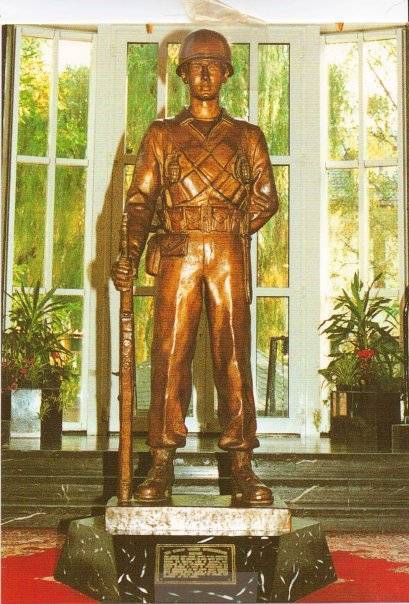The Story of Berlin Brigade
(Adapted from: „The Story of Berlin Brigade“, Pamphlet 870-2, US Command, Berlin and U.S. Army, Berlin, 1981.)
The Berlin Brigade formed at the height of the Berlin Wall crisis from units already in Berlin by General Orders from the Commander-in-Chief, United States Army, Europe. General Bruce Clarke ordered that from 1 December 1961, the core of the United States military presence in Berlin, the living symbol of America’s protection for the people of free Berlin, would be known as the United States Army Berlin Brigade.
July, 1945—Germany was divided into four sectors, each controlled by one of the victorious Allied countries (the U.S., Great Britain, France, and the Soviet Union). The great city of Berlin lay devastated. Two years of intense bombing and a fanatical struggle between the last-ditch defenders and the attacking Soviet Army had left the city in ruins.
Berliners struggled to obtain the bare necessities of life. Fighting ended on May 2, 1945 and Soviet troops occupied the city. Turned loose by their government, the Red Army looted Berlin in the name of reparations. They dismantled entire refrigeration plants, mills, whole factories, generator equipment, lathes and precision tools, and other spoils of war, loaded the items on rail cars and shipped them off to the Soviet Union.
The Americans arrived on July 1, but the Soviets did not relinquish control of the American sector for 12 days and finally left after considerable urging. U.S.-Soviet relations over Germany went downhill from there. Although all sides agreed that Germany should eventually be reunited as one nation, the Soviets wanted to make sure it was a communist state. The Soviets had used their two months in Berlin to fill key positions in the city with communist sympathizers. Every effort of the Allies to restore order and a semblance of normalcy to Berlin was met with some degree of Soviet opposition.
In 1948 the Soviets attempted to assert full control over Berlin by blocking all road and rail access to the city. Berliners received the bulk of their food and other supplies by rail from the Western Zones, and the Soviets apparently believed that it could starve the Berliners into submission and force the Western Allies to withdraw from Berlin.
In response, the Allies began the Berlin Airlift to supply the city by air, a feat many thought impossible due to the large amount of supplies needed and the limited cargo capacity of the available aircraft. Yet, against the odds, the airlift succeeded in supplying the city for 324 days until the Soviets admitted failure and lifted the blockade. Rather than push the Americans out of Berlin, the blockade strengthened U.S. resolve and led to a new bond of sympathy and mutual respect between the German and American people.
By 1948-49 observers began referring to the relationship between the U.S. and USSR as a „cold war.“ By 1950 the Berlin Brigade’s mission had changed from occupation to the mission that would define the Brigade for the next 40 years—to deter Soviet aggression, counter wide-spread civil unrest, and defend the city from the Soviet threat. Berlin, thus, became a central battlefield in the Cold War.
Beginning in November 1958 U.S.-Soviet relations in Berlin once again grew tense. Soviet demands and ultimatums prevented any forward movement on German reunification and posed a serious threat to the future status of the city. With hopes of reunification weakening and international tensions over Berlin running high, East Germans began „voting with their feet.“ West Berlin became the escape hatch for East German refugees. In July, 1961 as many as 3,000 escaped in a single day. The daily average for July and early August was about 1,800 per day. In terms of manpower, East Germany was bleeding to death. The Communist leadership solved the problem with brutal simplicity.
Before dawn on August 13, 1961, the East Germans sealed all but seven of the crossing points between the Soviet Sector and West Berlin. Twenty-eight miles of barbed-wire and barriers went up across the city and construction of the Berlin Wall began. President Kennedy ordered reinforcements to Berlin. On Sunday August 20th, 1,500 Soldiers of the 1st Battle Group, 18th Infantry (reinforced), moved by road from West Germany to Berlin and paraded through the city in full battle gear in front of Vice President Lyndon Johnson. For the next 3½ years, a different infantry battle group rotated through Berlin every 90 days, asserting U.S. access rights by moving over the autobahn through communist-controlled territory.
The Berlin Wall Crisis was the most serious in the city’s post-war history. Frequent confrontations with the Soviets at the autobahn and rail checkpoints and in East Berlin continued from 1958 to 1965. Soviet armored personnel carriers attempted to enter West Berlin, Soviet jet fighters buzzed the city intentionally creating sonic booms, and U.S. and Allied personnel experienced lengthy detentions. Throughout this period, the Berlin Brigade showed the flag and reassured the people of West Berlin that they would not be forced to live under communist rule. The strength of American resolve was reflected in the presence of American families, the spouses and children of American Soldiers assigned to the Berlin Brigade in the city. At the height of the Berlin Wall Crisis, an American reporter asked a calm Berliner if he was worried that the Allies might be forced out of the city. The Berliner shrugged. Yes, he was worried. But, he said, “Your families are still here.“
By the end of 1962, the crisis eased, but East-West tensions remained high. Soviet harassment of NATO personnel on the access routes also eased gradually. By the spring of 1967, the severe harassment of Allied military traffic had virtually ended.
Yet the wall remained, running through store fronts, through woods and along waterways, an inescapable reminder of the Brigade’s mission and the true nature of Communist government. Speaking at the wall, President John Kennedy stated, “Freedom has many difficulties and democracy is not perfect, but we have never had to put a wall up to keep our people in.” Decades later in 1987 President Ronald Regan stood in Berlin and challenged the Soviets to prove their good intentions, saying, “Mr. Gorbachev, tear down this wall.”
The Berlin Brigade’s mission ended peacefully with the end of the Cold War in 1989. On November 8, 1989, the East German government bowed to pressure, opened the border crossing, and thousands of East Germans flocked to West Berlin. The Wall had fallen. The final chapter of the Cold War concluded with the collapse of the Soviet Union in 1991.
Mission complete, the Berlin Brigade was finally inactivated in 1994. For almost 50 years the Brigade had stood as a symbol of U.S. resolve in a city that, more than any other place on earth, symbolized the stakes in the Cold War. The thousands of Soldiers who served in the Berlin Brigade proved that the Army can help win a war without ever firing a shot.

